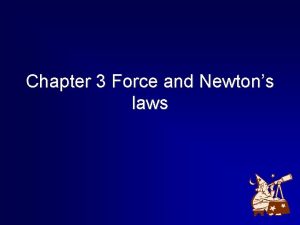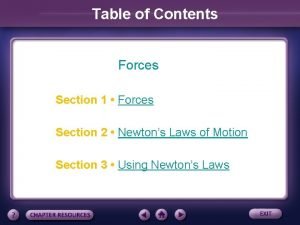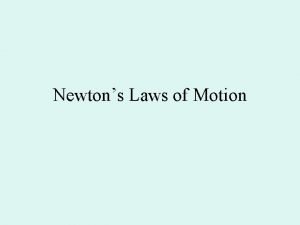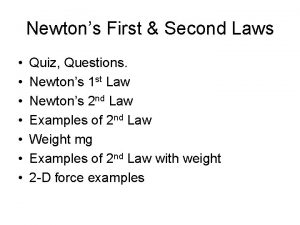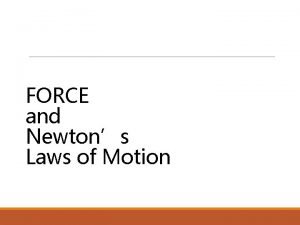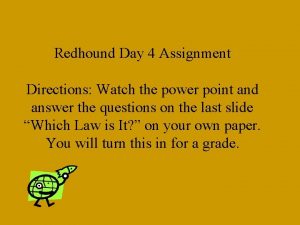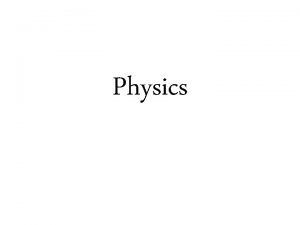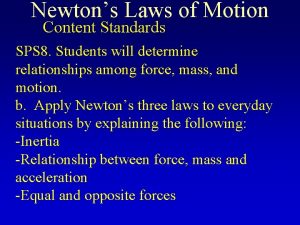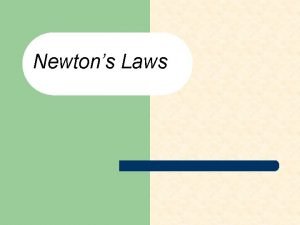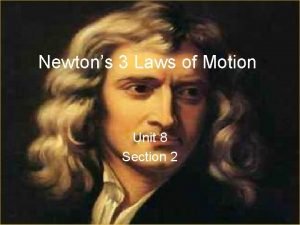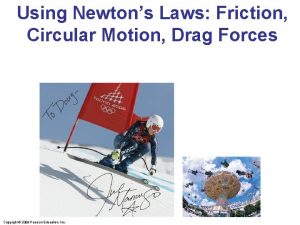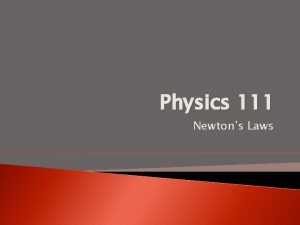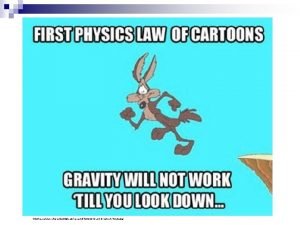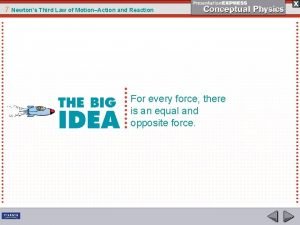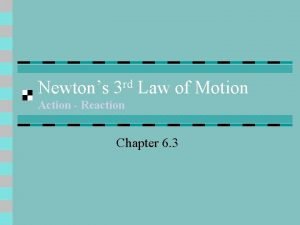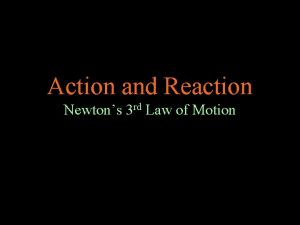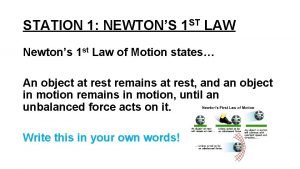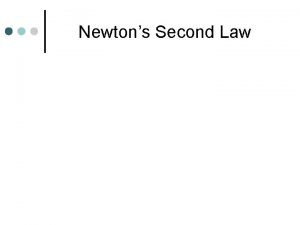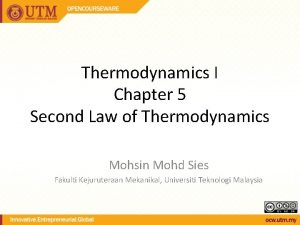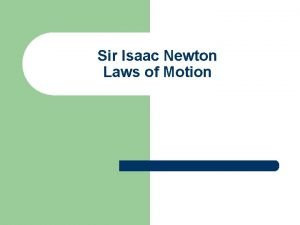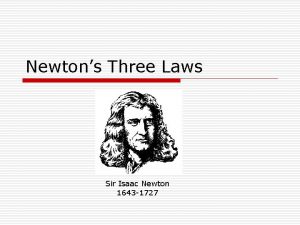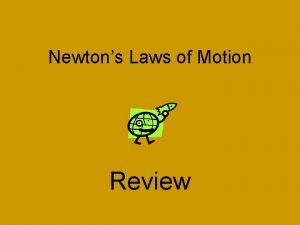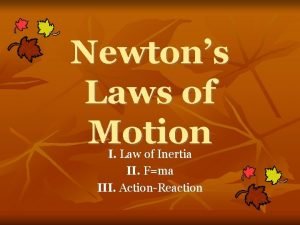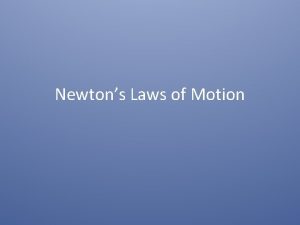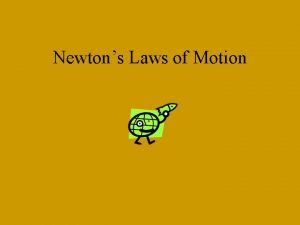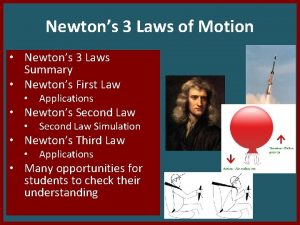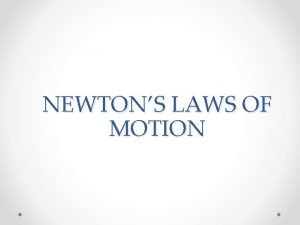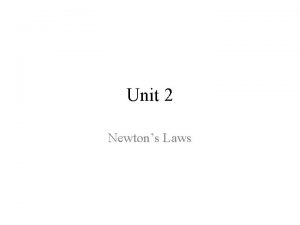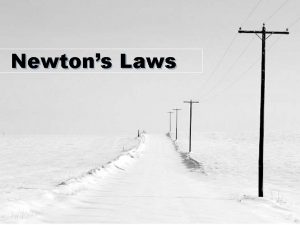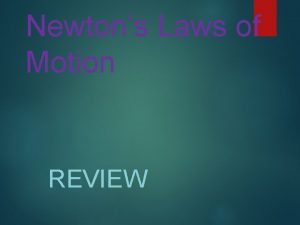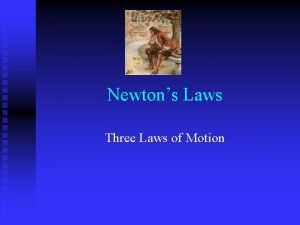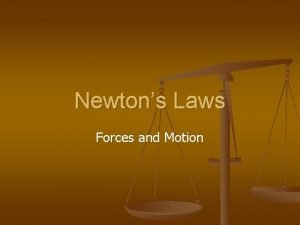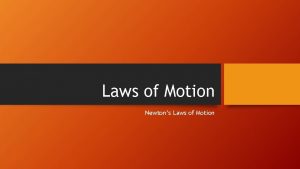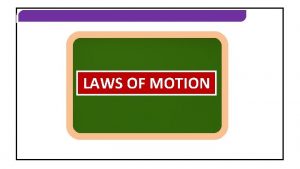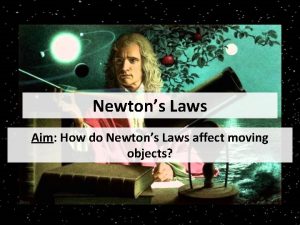Newtons Laws of Motion While most people know














































- Slides: 46

Newton’s Laws of Motion

While most people know what Newton's laws say, many people do not know what they mean (or simply do not believe what they mean).

Newton’s Laws of Motion n 1 st Law – Law of Inertia: An object at rest will stay at rest, and an object in motion will stay in motion at constant velocity, unless acted upon by an unbalanced force. 2 nd Law – Law of Acceleration, or F=ma n 3 rd Law – Law of Interaction: For every n action there is an equal and opposite reaction.

1 st Law of Motion (Law of Inertia) An object at rest will stay at rest, and an object in motion will stay in motion at constant velocity, unless acted upon by an unbalanced force.

1 st Law n Inertia is the tendency of an object to resist changes in its velocity: whether in motion or motionless. These pumpkins will not move unless acted on by an unbalanced force.

1 st Law n Once airborne, unless acted on by an unbalanced force (gravity and air – fluid friction), it would never stop!

1 st Law n Unless acted upon by an unbalanced force, this golf ball would sit on the tee forever.

Check for Understanding n n If you hold a coin above your head while in a bus that is not moving, the coin will land at your feet when you drop it. Where will it land if the bus is moving in a straight line at constant speed? It will fall in the same spot as if the bus wasn't moving. This is because once the bus is moving at a constant velocity, the coin is also moving at the velocity, and so are you. So in reality, when you dropped the coin, it moved forward in addition to falling down. However since you are moving the same speed as the coin, it appears to fall straight down. Motion is relative.

Check for Understanding n In the cabin of a jetliner that cruises at 600 km/hr, a pillow drops from an overhead compartment into your lap below. Since the jetliner is going so fast, why doesn’t the pillow slam into the rear of the plane when it falls out? What is the speed of the pillow relative to the jetliner? To the ground?

Net Force The sum of all forces on an object. The net force changes an object’s state of motion. n Ex: pushing a book across a table. n Gravity, air friction, & your pushing muscles = the net force n Newton (N) is the scientific unit of force/weight n

Net Force

Equilibrium for Objects at Rest (Demo spring scale & weight) n Tension – the state of being stretched (the spring scale experiences a “stretching” force) n Tension force acts upwards & weight acts downwards. 2 forces equal & opposite = 0, so it’s resting n

Equilibrium Rule When the net force on an object is 0, its state of motion doesn’t change, & the object is in mechanical equilibrium n Σ = vector (direction) SUM OF n F = forces n Forces acting upwards (+) balance w/forces acting downwards (-) n (+) and (-) = 0 n



Review (Speed & Equilib) Rosa’s sports car takes 60. 0 seconds to cover 1200 meters. What’s the average speed in meters per second? 2) Marisela walks at an average speed of 0. 5 m/s from the Bay Farm bridge to the Hornet (aircraft carrier). The trip takes her 1300 seconds. How far did she walk in meters? 3) A snail travels at an average speed of 0. 005 m/s across a 3. 0 meter walkway. How long does the snail take to cross the walkway? 4) Mario weighs 400 N & stands in the middle of a board that weighs 100 N that is hanging from 2 scales (one 1 on each side). Find the upward force of each scale. 5) Mario moves to the left, and the reading on the left scale (the one closest to him) is 350. What is the reading on the scale on the right? (DRAW DIAGRAM) 1)

Review - Equilibrium 1) 2) Mario weighs 400 N & stands in the middle of a board that weighs 100 N that is hanging from 2 scales (1 on each side). Find the upward force of each scale. Mario moves to the left, and the reading on the left scale (the one closest to him) is 350. What is the reading on the scale on the right? DRAW A PICTURE!

? ? ? Why then, do we observe every day objects in motion slowing down and becoming motionless seemingly without an outside force? It’s a force we sometimes cannot see – FRICTION.

Objects on earth, unlike the frictionless space the moon travels through, are under the influence of friction.

What is this unbalanced force that acts on an object in motion? n n A force that arises when an object rubs against something else There are four main types of friction: n n Sliding friction: ice skating Sliding friction: Rolling friction: bowling Rolling friction: Fluid friction (air or liquid): air or water resistance Fluid friction (air or liquid): Static friction: initial friction when moving an object Static friction:

Slide a book across a table and watch it slide to a rest position. The book comes to a rest because of the presence of a force that force being the force of friction which brings the book to a rest position.

n In the absence of a force of friction, the book would continue in motion with the same speed and direction - forever! (Or at least to the end of the table top. )

Newtons’s 1 st Law and You Don’t let this be you. Wear seat belts. Because of inertia, objects (including you) resist changes in their motion. When the car going 80 km/hour is stopped by the brick wall, your body keeps moving at 80 m/hour.

Support Force n n The force that supports an object against gravity Ex: book lying on table n n Support force is the upward force from the table Support force is equal to weight of book Support force + gravity = 0 Ex: bathroom scale (2 forces) n n n Downward pull of gravity (your weight) upward support of floor Scale shows support force

Equilibrium for Moving Objects n n n A moving object is in equilibrium if it moves steadily, without changing its state of motion A rolling ball is in equilibrium if it moves at constant velocity ΣF=0

2 nd Law The acceleration produced by a net force acting on an object is directly proportional to the magnitude of the net force, is in the same direction as the net force, and is inversely proportional to the mass of the object.


2 nd Law n n When mass is in kilograms and acceleration is in m/s/s (m/s 2), the unit of force is in newtons (N). One Newton is equal to the force required to accelerate one kilogram of mass at one meter/second.

2 nd Law (F = m x a) n How much force is needed to accelerate a 1400 kilogram car 2 meters per second/per second? Write the formula F = m x a Fill in given numbers and units F = 1400 kg x 2 meters per second/second Solve for the unknown n 2800 kg-meters/second or 2800 N n n n

If mass remains constant, doubling the acceleration, doubles the force. If force remains constant, doubling the mass, halves the acceleration.

Newton’s 2 nd Law proves that different masses accelerate to the earth at the same rate, but with different forces. • We know that objects with different masses accelerate to the ground at the same rate. • However, because of the 2 nd Law we know that they don’t hit the ground with the same force. F = ma 98 N = 10 kg x 9. 8 m/s/s 9. 8 N = 1 kg x 9. 8 m/s/s


Check Your Understanding n 1. What acceleration will result when a 24 N net force applied to a 4 kg object? A 8 kg object? n n n 2. A net force of 36 N causes a mass to accelerate at a rate of 4 m/s 2. Determine the mass. 3. What is the force on a 1000 kg elevator that is falling freely at 9. 8 m/sec? 4. A frictional force of 10 N acts against a forward force of 25 N. If the forward force is applied to a 12 -kg object, what is the acceleration of the object?

Check Your Understanding 1. What acceleration will result when a 24 N net force applied to a 4 kg object? 8 kg? 24 N = 4 kg x 6 m/s 2 24 N = 8 kg x 3 m/s 2 n 2. A net force of 36 N causes a mass to accelerate at a rate of 4 m/s 2. Determine the mass. 36 N = 9 kg x 4 m/s 2 n 3. What is the force on a 1000 kg elevator that is falling freely at 9. 8 m/s 2? 9800 kg-m/s 2 or 9800 N n n 4. A frictional force of 10 N acts against a forward force of 25 N. If the forward force is applied to a 12 -kg object, what is the acceleration of the object? 1. 25 m/s 2

Mass vs Weight n n n MASS IS NOT WEIGHT! Mass – the amount of matter in an object. Weight – the force due to gravity that acts on an object’s mass The 2 are directly proportional: object with large mass has large weight, object with little mass has little weight.

3 rd Law n For every action, there is an equal and opposite reaction.

3 rd Law According to Newton, whenever objects A and B interact with each other, they exert forces upon each other. When you sit in your chair, your body exerts a downward force on the chair and the chair exerts an upward force on your body.

3 rd Law There are two forces resulting from this interaction - a force on the chair and a force on your body. These two forces are called action and reaction forces.

Newton’s 3 rd Law in Nature n n Consider the propulsion of a fish through the water. A fish uses its fins to push water backwards. In turn, the water reacts by pushing the fish forwards, propelling the fish through the water. The size of the force on the water equals the size of the force on the fish; the direction of the force on the water (backwards) is opposite the direction of the force on the fish (forwards).

3 rd Law Flying gracefully through the air, birds depend on Newton’s third law of motion. As the birds push down on the air with their wings, the air pushes their wings up and gives them lift.

n n n Consider the flying motion of birds. A bird flies by use of its wings. The wings of a bird push air downwards. In turn, the air reacts by pushing the bird upwards. The size of the force on the air equals the size of the force on the bird; the direction of the force on the air (downwards) is opposite the direction of the force on the bird (upwards). Action-reaction force pairs make it possible for birds to fly.

Other examples of Newton’s Third Law n The baseball forces the bat to the left (an action); the bat forces the ball to the right (the reaction).

3 rd Law n Consider the motion of a car on the way to school. A car is equipped with wheels which spin backwards. As the wheels spin backwards, they grip the road and push the road backwards.

3 rd Law The reaction of a rocket is an application of the third law of motion. Various fuels are burned in the engine, producing hot gases. The hot gases push against the inside tube of the rocket and escape out the bottom of the tube. As the gases move downward, the rocket moves in the opposite direction.

Check for Understanding n A speeding bus makes contact with a bug that splatters onto the windshield. n n Compare the force of the bug on the windshield to the force of the windshield on the bug. Compare the acceleration of the bug and the acceleration of the bus.

Check for Understanding n How does a rocket in outer space move when there is no air to “push” against?
 Colin skateboards down the sidewalk
Colin skateboards down the sidewalk 3 newton's laws
3 newton's laws Newtons 3 laws
Newtons 3 laws What is newton's 3 law of motion
What is newton's 3 law of motion Facts about newtons laws
Facts about newtons laws Newton's law of gravitation
Newton's law of gravitation What are newton's 3 laws
What are newton's 3 laws Third law of newton
Third law of newton Section 3 using newtons laws
Section 3 using newtons laws Section 3 using newtons laws
Section 3 using newtons laws Section 3 using newtons laws
Section 3 using newtons laws First law of motion facts
First law of motion facts Newtons 3 laws quiz
Newtons 3 laws quiz Newton's 3rd law example
Newton's 3rd law example Newton's three laws
Newton's three laws Law of acceleration
Law of acceleration Newton law
Newton law Newton's first law example
Newton's first law example When the pellet fired into the spiral tube
When the pellet fired into the spiral tube 3 law of newton
3 law of newton Newton's first law of motion examples
Newton's first law of motion examples Newtons laws
Newtons laws Newtons laws
Newtons laws Newtons 3 rd law of motion
Newtons 3 rd law of motion Newtons 3 rd law of motion
Newtons 3 rd law of motion Chapter 8 ask newton
Chapter 8 ask newton Newtons 3 rd law of motion
Newtons 3 rd law of motion Newton's second law meme
Newton's second law meme Newtons third law of motion
Newtons third law of motion Newton's third law
Newton's third law Newtons 3 rd law of motion
Newtons 3 rd law of motion Newtons 3 rd law of motion
Newtons 3 rd law of motion Newtons 1st law.
Newtons 1st law. Second law of newton
Second law of newton 2st law of motion definition
2st law of motion definition Newtons law of motion
Newtons law of motion Pernyataan do while
Pernyataan do while Facts about montesquieu
Facts about montesquieu Know history know self
Know history know self Normalizing flow
Normalizing flow God of angel armies
God of angel armies Perpetual motion laws
Perpetual motion laws Isaac newton laws of motion
Isaac newton laws of motion Three laws of newton
Three laws of newton What are the 3 laws of motion?
What are the 3 laws of motion? F=ma
F=ma Law of inertia
Law of inertia








